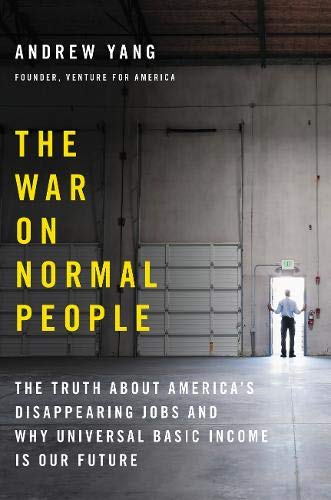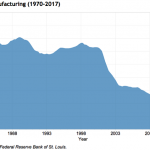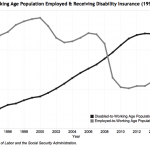By Andrew Yang
You would have to have been asleep these past years not to have noticed that manufacturing jobs have been disappearing in large numbers. In 2000 there were still 17.5 million manufacturing workers in the U.S. Then, the numbers fell off a cliff, plummeting to less than 12 million before rebounding slightly starting in 2011.
More than 5 million manufacturing workers lost their jobs after 2000. More than eighty percent of the jobs lost – or 4 million jobs – were due to automation. Men make up 73% of manufacturing workers, so this hit working class men particularly hard. About one in six working-age men in America is now out of the workforce, one of the highest rates among developed countries.
What happened to these 5 million workers? A rosy economist might imagine that they found new manufacturing jobs, or were retrained and reskilled for different jobs, or maybe they moved to another state for greener pastures.
In reality, many of them left the workforce. One Department of Labor survey in 2012 found that 41 percent of displaced manufacturing workers between 2009 and 2011 were either still unemployed or dropped out of the labor market between within three years of losing their jobs. Another study out of Indiana University found that 44 percent of 200,000 displaced transportation equipment and primary metals manufacturing workers in Indiana between 2003 and 2014 had no payroll record at all by 2014, and only 3 percent graduated from a public college or university in Indiana during that time period. The study noted, “Very few went back to school, and relatively few seemed to avail themselves of a lot of the government programs available to assist displaced workers.
The manufacturing jobs that still exist require more education and technical skills as factories have become more advanced and automated. Jobs in manufacturing for people with graduate degrees grew by 32 percent after 2000, even as overall employment in the sector was plummeting. Of course, as we’ve seen most people don’t have graduate degrees or even college or associate’s degrees, and it is unrealistic for many to get them.
“The recession led to this huge wiping out of one-industry towns, particularly in those places that were heavily dependent on the industrial or manufacturing economy,” says Steve Glickman, CEO of the Economic Innovation Group. “We’re asking: What’s around the corner for them? And we’re seeing a shockingly low rate of new businesses that can become the new employers for those regions of the country.”
Get Evonomics in your inbox
How do the 40 percent of displaced manufacturing workers who don’t find new jobs survive? The short answer is that many became destitute and applied for disability benefits. Disability rolls shot up starting in 2000, rising by 3.5 million, with the numbers increasing dramatically in Ohio, Michigan, Pennsylvania, and other manufacturing-heavy states. In Michigan, about half of the 310,000 residents who left the workforce between 2003 and 2013 went on disability. Many displaced manufacturing workers essentially entered a new underclass of government dependents who have been left behind.
This is a good indicator of what will occur when truck drivers lose their jobs. Truck drivers’ average age is 49, 94% are male, and they are typically high school graduates. Driving a truck is the most popular job in 29 states – there are 3.5 million truck drivers nationwide.
Trucks that drive themselves are already rolling out around the world. Self-driving trucks successfully made deliveries in Nevada and Colorado in 2017. Rio Tinto has 73 autonomous mining trucks hauling iron ore 24 hours a day in Australia. Europe saw its first convoys of self-driving trucks cross the continent in 2016. In 2016 Uber bought the self-driving truck company Otto for $680 million and now employs 500 engineers to perfect the technology. Google spun off its self-driving car company Waymo, which is working on self-driving trucks with the big truck manufacturers Daimler and Volvo.
Jim Scheinman, a venture capitalist at Maven Ventures who has backed startups in both autonomous trucks and cars, says that self-driving trucks will arrive significantly before cars because highway driving is so much easier. Highways, the domain of semi-trucks, are much less complex than urban areas, with fewer intersections and clearer road markings. And the economic incentives around freight are much higher than with passenger cars.
Morgan Stanley estimated the savings of automated freight delivery to be a staggering $168 billion per year in saved fuel ($35 billion), reduced labor costs ($70 billion), fewer accidents ($36 billion) and increased productivity and equipment utilization ($27 billion). That’s an enormously high incentive to show drivers to the door – it would actually be enough to pay the drivers their $40,000 a year salary to stay home and still save almost $100 billion per year.
Switching to automated drivers will not only save billions, but it also has the potential to save thousands of lives. Crashes involving large trucks killed 3,903 people in the US in 2014, according to the National Highway Traffic Safety Administration, and a further 110,000 people were injured. More than 90% of the accidents were caused at least in part by driver error. Driver fatigue is a factor in roughly one out of seven fatal accidents. Most of us when we were taught to drive growing up were told to avoid trucks on the highway. There’s a reason for that.
So the incentives to adopt automated truck driving are massive – tens of billions of dollars saved annually plus thousands of lives. They are so large that one could argue it is important for national competitiveness and human welfare that this happen as quickly as possible. Adding to the incentives is that many freight companies report labor shortages because they can’t find enough people willing to take on the physically demanding and punishing job of spending hundreds of hours sitting in a confined space. Truck drivers spend 240 nights per year away from home staying in truckstops and motels and 11 hours per day on the road. Obesity, diabetes, smoking, inactivity, and high blood pressure are common, with one study saying 88 percent of drivers had at least one risk factor for chronic disease.
Many, however, will argue for the preservation of truck driving because they recognize just how problematic it would be for such a large number of uneducated male workers to be displaced quickly.
Taking even a fraction of the 3.5 million truckers off the road will have ripple effects far and wide. It is impossible to overstate the importance of truck drivers to regional economies around the country. As many as 5.2 million workers serve the needs of truck drivers at truck stops, diners, motels, and other businesses around the country. Over 2,000 truck stops around the country serve as dedicated hotels, restaurants, grocery stores and entertainment hubs for truckers every day. If one assumes that each trucker spends only $5k a year on consumption on the road (about $100 per week), that’s a $17.5 billion economic hit in communities around the country. Beyond the hundreds of thousands of additional job losses, many communities may risk losing a sense of purpose without thousands of truckers coming through each day. For example, in Nebraska one out of every 12 workers – 63,000 workers – works in and supports the trucking industry.
Truck drivers do not see it coming. Indeed, when Bloomberg’s Shift Commission in 2017 asked truck drivers about how concerned they were about their jobs being replaced by automation, they almost uniformly weren’t concerned at all. Let me assure you its coming. Elon Musk recently announced that Tesla will be debuting a freight truck in late 2017. Elon also proclaimed that by 2019, all new Teslas will be self-driving. “Your car will drop you off at work, and then it will pick other people up and make you money all day until it’s time to pick you up again,” Musk proclaimed. ”This will 100% happen.” It is obvious that Tesla trucks will eventually have the same self-driving capabilities as their cars. Other autonomous vehicle companies report similar timelines, with 2020 being the first year of mass adoption. –And it’s not just those driving trucks who are at risk. A senior official at one of the major ride-sharing companies told me that their internal projections are that half of their rides will be given by autonomous vehicles by 2022. This has the potential to affect about 300,000 Uber and Lyft drivers in the U.S..
The replacement of drivers will be one of the most dramatic, visible battlegrounds between automation and the human worker. Companies can eliminate the jobs of call center workers, retail clerks, fast food workers and the like with minimal violence and fuss. Truck drivers will be different.
Right now, the federal government has said that it will allow autonomous vehicles in any states that permit them. One industry report noted that, “the [US] Department of Transportation is throwing its full support behind development of autonomous vehicles as a way to improve safety on our roadways . . .” In 2016 the trucking industry spent $9.1 million on lobbying and the Ohio government has already committed $15 million to set up a 35-mile stretch of highway outside Columbus for testing self-driving trucks. Arizona, California and Nevada have begun allowing self-driving car trials in their states, and others will follow.
Will truckers and the industry fight back? Back in the 1950s, truckers were highly unionized, with the Teamsters being legendary in their aggressiveness. Today, only about 13% of U.S. truckers are unionized and 90% of the trucking industry is made up of small businesses with ten or less trucks. About 10% of truck drivers – 350,000 – are solo owner operators who own their own trucks; the trucking companies have been pushing drivers to buy or lease their own trucks to reduce overhead.
It will happen in stages. First, there will be automated trucks with a human driver as a failsafe. The technology will allow truckers to go beyond their current 11 hours per day on the road as the driver will be able to rest and do other things during long stretches. This will increase the productivity of trucks and equipment, and likely the reduction in wages of truckers as the pay scale changes. The next stage will have convoys of trucks with the lead truck having a driver and the others following automatically, which lowers wind resistance and fuel costs. There will be docking stations outside urban areas where drivers will enter the trucks for the last 10 miles.
At some point, as the industry becomes more and more automated, truck drivers will realize that the combination of much more efficient trips and lower need for labor will dramatically shrink their total employment. Those that have other options will flee the field. But for many, their opportunities outside of truck driving will be minimal, and they know it. Many are ex-military – about 5% of Gulf War veterans – 80,000 – worked in transportation in 2012. They will be proud and desperate. What might happen when the 350,000 American truckers who bought or leased their own trucks are unemployed and angry? All it takes is one out of 350,000 to lead the others. It doesn’t take a big leap of the imagination to imagine mass protests that could block highways, seize up the economy and wreak havoc.
The best estimates for when this will unfold are between 2020 and 2030. This starts in two years.
 Excerpt from The War on Normal People: The Truth About America’s Disappearing Jobs and Why Universal Basic Income Is Our Future by Andrew Yang, Hachette Books (2018).
Excerpt from The War on Normal People: The Truth About America’s Disappearing Jobs and Why Universal Basic Income Is Our Future by Andrew Yang, Hachette Books (2018).
Donating = Changing Economics. And Changing the World.
Evonomics is free, it’s a labor of love, and it's an expense. We spend hundreds of hours and lots of dollars each month creating, curating, and promoting content that drives the next evolution of economics. If you're like us — if you think there’s a key leverage point here for making the world a better place — please consider donating. We’ll use your donation to deliver even more game-changing content, and to spread the word about that content to influential thinkers far and wide.
MONTHLY DONATION
$3 / month
$7 / month
$10 / month
$25 / month
You can also become a one-time patron with a single donation in any amount.
If you liked this article, you'll also like these other Evonomics articles...
Pare De Reclamar Do Tamanho Do Governo. Comece a Se Preocupar Com Quem O Controla.
Everything You Need to Know About Laissez-Faire Economics
Donald Trump Is Pro-Business, Not Pro-Market. Why This Is a Big Problem
Neoliberalism: How Seeing Markets as Perfect Turned into an Ideology Justifying Crony Capitalism
BE INVOLVED
We welcome you to take part in the next evolution of economics. Sign up now to be kept in the loop!




























